Bengal Sultanate
This article needs additional citations for verification. (August 2019) |
Sultanate of Bengal Shahi Bangla শাহী বাংলা | |||||||||||||||
|---|---|---|---|---|---|---|---|---|---|---|---|---|---|---|---|
| 1352–1576 | |||||||||||||||
 | |||||||||||||||
| Status | Sultanate | ||||||||||||||
| Capital | Pandua (1352-1450) Sonargaon (1390-1411)[note 1][1] Gaur (1450-1565) Tandah (1565-1576) | ||||||||||||||
| Common languages | Persian, Bengali (official) Arabic (religious) | ||||||||||||||
| Religion | Islam (official) | ||||||||||||||
| Government | Absolute monarchy | ||||||||||||||
| History | |||||||||||||||
• Unification of Bengal | 1352 | ||||||||||||||
• Mughal invasion | 1576 | ||||||||||||||
| Currency | Tanka | ||||||||||||||
| |||||||||||||||
| Today part of | Bangladesh India Myanmar | ||||||||||||||
The Sultanate of Bengal, (also known as the Bengal Sultanate; Bengali Sultanate,[2] Bangalah (Persian: بنگاله Bangālah, Bengali: বাঙ্গালা/বঙ্গালা) and Shahi Bangalah (Persian: شاهی بنگاله Shāhī Bangālah, Bengali: শাহী বাঙ্গলা)),[3] was an empire and the sovereign power[4][5][6] of Bengal for much of the 14th, 15th and 16th centuries. It had a circle of vassal states, including Odisha in the southwest, Arakan in the southeast,[7] and Tripura in the east.[8] In 1494, the Bengal Sultanate reached the peak of its territorial growth with control over Kamrup and Kamata. It was known as one of the major trading nations of the medieval world.[8] During the 16th-century, Bengal suffered two major defeats by the Suri Empire and the Mughal Empire.
The Bengal Sultanate was a Sunni Muslim monarchy with Indo-Turkish, Arab, Habshi and Bengali Muslim elites.[9] The pre-Islamic Bengali Hindu community continued to play an important role in government, the military, land ownership and the arts. While Bengali was the most widely spoken language, Persian was used as an official, diplomatic and commercial language. The capital cities of Pandua and Gaur were adorned with stately medieval buildings.[10] Other cities included "mint towns" which produced the taka. Prominent cities included the river port of Sonargaon, the Mosque City of Bagerhat, and the seaports of Chittagong and Satgaon. The Bengal Sultanate was connected to states in Asia, Africa, the Indian Ocean, and Europe through maritime links and overland trade routes. The Bengal Sultanate was a major trading center on the coast of the Bay of Bengal. It attracted immigrants and traders from different parts of the world. Bengali ships and merchants traded across the region, including in Malacca, China, and the Maldives.
The Bengal Sultanate was described by contemporary European and Chinese visitors as a relatively prosperous kingdom. Due to the abundance of goods in Bengal, the region was described as the "richest country to trade with". The Bengal Sultanate left a strong architectural legacy. Buildings from the period show foreign influences merged into a distinct Bengali style.[9] The Bengal Sultanate was also the largest and most prestigious authority among the independent medieval Muslim-ruled states in the history of Bengal.[11]
History
Bengal was gradually absorbed into the Delhi Sultanate during the 1200s. It began with Bakhtiar Khilji's conquest of Gauda between 1202 and 1204 during the reign of Muhammad of Ghor. The Delhi Sultan Iltumish declared Bengal as a province of Delhi in 1225. The Delhi Sultans attempted to govern Bengal through appointed governors. But Delhi could not succeed given the considerable overland distance with Bengal. Ambitious governors rebelled and ruled as independent rulers until being suppressed militarily by the Delhi Sultanate. However, there were capable rulers among the rebels, including Yuzbak Shah (1257), Tughral Khan (1271-1282), and Shamsuddin Firoz Shah (1301-1322). The latter achieved the Conquest of Sylhet and established a strong administration in eastern and south-western Bengal. In 1325, the Delhi Sultan Ghiyath al-Din Tughluq reorganized the province into three administrative regions, with Sonargaon ruling eastern Bengal; Gauda ruling northern Bengal; and Satgaon ruling southern Bengal. Even this arrangement broke down. By 1338, the three administrative regions had separatist Sultans, including Fakhruddin Mubarak Shah in Sonargaon; Alauddin Ali Shah in Gauda, and Shamsuddin Ilyas Shah in Satgaon.[12] Fakhruddin conquered Chittagong in 1340 and was succeeded by his son Ikhtiyaruddin Ghazi Shah in 1349. Shamsuddin Ilyas Shah (or just Ilyas Shah) defeated Alauddin Ali Shah and secured control of Gauda. He then defeated Ikhtiyaruddin of Sonargaon. By 1352, Ilyas Shah emerged victorious among the Bengali triad.
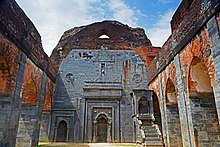
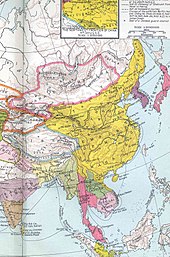
Ilyas Shah established his capital in Pandua. He unified the delta of Ganges, Brahmaputra and Meghna Rivers into the Sultanate of Bengal. Ilyas Shah waged wars and raids against several city-states and kingdoms in the eastern subcontinent. He conquered eastern Bengal and northern Bihar. He led the first Muslim army into Nepal, raided the Kathmandu Valley, and returned to Bengal with treasures.[13] He controlled an area stretching from Assam in the east to Varanasi in the west.[12] In 1353, Ilyas Shah was defeated by Delhi Sultan Firuz Shah Tughluq in the Siege of Ekdala Fort during the Bengal Sultanate-Delhi Sultanate War. Bengal agreed to pay a tribute to the Delhi Sultan. Despite losing control of many conquered areas, Ilyas Shah remained in firm control of Bengal.[12]
Ilyas Shah founded the Indo-Turkic Ilyas Shahi dynasty which ruled Bengal until 1490. His son and successor Sikandar Shah defeated Delhi Sultan Firuz Shah Tughluq during the second Siege of Ekdala Fort in 1359. A peace treaty was signed between Delhi and Bengal, with the former recognizing the independence of the latter. Firuz Shah Tughluq gave a golden crown estimated to be worth 80,000 taka to Sikandar Shah. The peace treaty ensured Bengal's independence for two centuries.[14]
Sikandar Shah's reign lasted for three decades. The Adina Mosque was built during his reign. The mosque's design was based on the Great Mosque of Damascus- a style used during the introduction of Islam in new areas. During this time, much of the agricultural land was controlled by Hindu zamindars, which caused tensions with Muslim taluqdars.[15]
Bengal became the eastern frontier kingdom among medieval Islamic states.[16] In the 14th-century, Islamic kingdoms stretched from Muslim Spain in the west to the Indian subcontinent in the east. The Islamic kingdoms had multiethnic elites. Persian and Arabic were used alongside local languages. Persian was used as a diplomatic and commercial language. Arabic was the liturgical language of the clergy. In Bengal, the Bengali language became a court language and was the main vernacular language under Muslim rule.[17]
The third Sultan Ghiyasuddin Azam Shah began expanding Bengal's influence abroad. He began to send embassies to Ming China, which continued as a tradition during the reigns of his successors. Ghiyasuddin also sponsored construction projects in Arabia. He exchanged letters and poetry with the Persian poet Hafez.[18] The Bengal Sultans pledged nominal allegiance to the Abbasid Caliphate in Cairo. The coins of the Bengal Sultans often bore the name of the contemporary Abbasid Caliph.[19]
During the early 15th-century, the Ilyas Shahi rule was challenged by Raja Ganesha, a powerful Hindu landowner, who managed to place his son (a convert to Islam), Jalaluddin Muhammad Shah, on the throne. Jalaluddin had a relatively short-lived but significant reign, during which he helped an Arakanese king to achieve the Reconquest of Arakan. Jalaluddin established control over Fatehabad.[20] Jalaluddin also promoted more Bengali elements into the architecture of the sultanate. Jalaluddin was initially loyal to the Abbasid Caliph but later declared himself as the Caliph in a sign of Bengali Muslim independence.[21] The Ilyas Shahi dynasty was restored in 1432.
Nine kings ruled Bengal from Pandua over the course of ten decades. They built palaces, forts, bridges, mosques, and mausoleums.[22] Chinese envoy Ma Huan described the city at the time in his travel accounts, which state that "the city walls are very imposing, the bazaars well-arranged, the shops side by side, the pillars in orderly rows, they are full of every kind of goods". Pandua was an export center for cloth and wine. At least six varieties of fine muslin and four types of wine were found in Pandua. High-quality paper was produced from the bark of Pandua's mulberry trees.[23] Sultan Mahmud Shah of Bengal shifted the capital from Pandua to Gaur in 1450. One of the probable reasons behind the move was a change in the course of nearby rivers.[24]

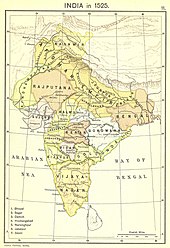
According to historical records, third Bengali Sultan Ghiyasuddin Azam Shah held his court in Sonargaon, in addition to Pandua. The travel accounts of Chinese envoys state that the Sultan lived in a palace near the river port of Sonargaon. The river port had shipping links to China, Southeast Asia, and the Middle East. In 1406, Ma Huan found Sonargaon as a large metropolis. Other Chinese envoys provided descriptions of a fortified walled city. Sonargaon was a center of Sufi education and Persian literature. Sultan Ghiyasuddin invited the Persian poet Hafez to settle in Sonargaon. The institutions founded by Abu Tawwama during the Delhi Sultanate were maintained by his successors in the Bengal Sultanate, including the Sufi preachers Saiyid Ibrahim Danishmand, Saiyid Arif Billah Muhammad Kamel, Saiyid Muhammad Yusuf and others.[25]
The reign of Mahmud Shah witnessed greater control over the Sundarbans. The governor of the Sundarbans, Khan Jahan Ali, built the mint town of Khalifatabad.[26] Like many other officials, Khan Jahan had settled in Bengal after Timur's sack of Delhi. During the reign of Rukunuddin Barbak Shah, the Kingdom of Mrauk U conquered Chittagong. The late 1480s saw four usurper Sultans from the Abyssinian mercenary corps. Tensions between different Muslim communities often affected the sultanate.[15] After a period of instability, Alauddin Hussain Shah gained control of Bengal in 1494 when he was prime minister. As Sultan, Hussain Shah ruled till 1519. The dynasty he founded reigned till 1538. Muslims and Hindus jointly served in the royal administration during the Hussain Shahi dynasty. This era is often regarded as the golden age of the Bengal Sultanate, in which Bengali territory included areas of Arakan, Orissa, Tripura, and Assam.[15] Alauddin Hussain Shah conquered large parts of Assam during the Bengal Sultanate-Kamata Kingdom War. He overthrew the Hindu Khen dynasty. Alauddin also restored Bengali sovereignty in Chittagong and northern Arakan after the Bengal Sultanate–Kingdom of Mrauk U War of 1512–1516.
Individual Portuguese merchants are recorded to have lived in the Bengal Sultanate's capital of Gaur. Embassies from Portuguese India frequented Bengal during the 16th-century.[27] Portuguese politics played out in Gaur as a reflection of contradictions in contemporary Portugal.[27] The Portuguese provided vivid descriptions of Gaur. They compared the affluence of Gaur with Lisbon. The city included a citadel, a royal palace and durbar, mosques, houses for the rich, and bustling bazaars. Portuguese historian Castenhada de Lopez described the houses of Gaur as being one-storeyed with ornamental floor tiles, courtyards, and gardens. Gaur was the center of regional politics. The Sultan of Bengal gave permission for establishing the Portuguese settlement in Chittagong. During the period of the Iberian Union, there was no official Portuguese sovereignty over Chittagong. The Portuguese trading post was dominated by pirates who allied with the Arakanese against Bengal.

The absorption of Bengal into the Mughal Empire was a gradual process. It began with the defeat of Bengali forces under Sultan Nasiruddin Nasrat Shah by the first Mughal ruler Babur at the Battle of Ghaghra. The second Mughal ruler Humayun occupied the Bengali capital of Gaur during the invasion of Sher Shah Suri against both the Mughals and Bengal Sultans. Humayun later took refuge in the Safavid Empire in Persia. Sher Shah Suri succeeded in conquering Bengal and began renovating the Grand Trunk Road.[28] The Suri government appointed successive governors to administer Bengal. The third governor Muhammad Khan Sur declared independence after the death of Islam Shah Suri. Muhammad Khan ended the interrupting period of Delhi's rule and re-established the Bengal Sultanate.
The Pashtun Karrani dynasty was the last ruling dynasty of the sultanate. According to the Riyaz-us-Salatin, Sultan Sulaiman Khan Karrani shifted the capital from Gaur to Tanda in 1565.[29] Mughal rule formally began with the Battle of Raj Mahal when the last reigning Sultan of Bengal was defeated by the forces of Akbar. The Mughal province of Bengal Subah was created. The eastern deltaic Bhati region remained outside of Mughal control until being absorbed in the early 17th-century. The delta was controlled by a confederation of twelve aristocrats of the former sultanate, who became known as the Twelve Bhuiyans. Their leader was Isa Khan, a former nobleman of the sultanate. The confederation was made up of petty kingdoms. The Mughal government eventually suppressed the remnants of the sultanate in the Bhati area and brought all of Bengal under full Mughal control.
Administration and military

The Bengal Sultanate was an absolute monarchy. The Ilyas Shahi dynasty cultivated a Persianate society. It reflected the pre-Muslim Persian tradition of monarchy and statecraft. The courts of the capital cities sanctified the Sultan, used Persianised royal paraphernalia, adopted an elaborate court ceremony modeled on the Sasanian imperial paradigm, employed a hierarchical bureaucracy, and maintained Islam as the state religion. The rise of Jalaluddin Muhammad Shah saw more native elements inducted in the courts.[30] The Hussain Shahi dynasty employed many Hindus in the government and promoted a form of religious pluralism.[31]
Military strength was the existential basis of medieval kingdoms in Bengal and other parts of India. The Sultans had a well-organised army, including cavalry, artillery, infantry and war elephants; and a navy. Due to the riverine geography and climate, it was not feasible to use cavalry throughout the year in Bengal. The cavalry was probably the weakest component of the Bengal Sultanate's army, as the horses had to be imported from foreign countries. The artillery was an important section. Portuguese historian João de Barros opined that the military supremacy of Bengal over Arakan and Tripura was due to its efficient artillery. The artillery used cannons and guns of various sizes.[32]
The paiks formed the vital part of the Bengal infantry during this period. There were occasions when the paiks also tackled political situations. The particular battle array of the foot-soldiers who used bows, arrows and guns attracted the attention of Babur.[32]
War elephants played an important part in the Bengal army. Apart from carrying war materials, elephants were also used for the movement of the armed personnel. In riverine Bengal the usefulness of elephants, though very slow, could not be minimised. The navy was of prime necessity in riverine Bengal. In fact, the cavalry could ensure the hold over this country for a period of six months whereas the boats backed by the paiks could command supremacy over the other half of the year. Since the time of Iwaz Khalji, who first organised a naval force in Islamic Bengal, the war boats played an important role in the political affairs of the country. The chief of the admiralty had various responsibilities, including shipbuilding, river transport, to fit out strong boats for transporting war elephants; to recruit seamen; to patrol the rivers and to collect tolls at ghats. The efficiency of the navy eroded during the Hussain Shahi dynasty. The Sultans also built forts, including temporary mud walled forts.[32]
The following is a list of the conflicts faced and resisted by the Bengal Sultanate[citation needed]:
| Name of Conflict | Belligerents | Outcome | |
|---|---|---|---|
| Allies | Opponent(s) | ||
| Bengal Sultanate-Delhi Sultanate War (1353–1359) | Velanati Chodas | Delhi Sultanate | Victory
|
| Bengal Sultanate-Jaunpur Sultanate War (1415-1420) | Timurid Empire Ming China |
Jaunpur Sultanate | Victory
|
| Reconquest of Arakan (1429-1430) | Launggyet | Burmese Kingdoms | Victory
|
| Bengal Sultanate–Kamata Kingdom War (1498) | Kamata Kingdom | Victory
| |
| Bengal Sultanate-Kingdom of Mrauk U War of 1512-1516 | Kingdom of Mrauk U | Victory
| |
| Battle of Ghaghra (1529) |
Eastern Afghan Confederates | Mughal Empire | Defeat
|
| Battle of Raj Mahal (1576) |
Mughal Empire | Defeat
| |
Economy
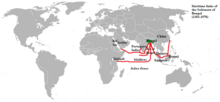

The economy of the Bengal Sultanate inherited earlier aspects of the Delhi Sultanate, including mint towns, a salaried bureaucracy and the jagirdar system of land ownership. The production of silver coins inscribed with the name of the Sultan of Bengal was a mark of Bengali sovereignty.[33]
Bengal was more successful in perpetuating purely silver coinage than Delhi and other contemporary Asian and European governments. There were three sources of silver. The first source was the leftover silver reserve of previous kingdoms. The second source was the tribute payments of subordinate kingdoms which were paid in silver bullion. The third source was during military campaigns when Bengali forces sacked neighboring states.[34]
The apparent vibrancy of the Bengal economy in the beginning of the 15th-century is attributed to the end of tribute payments to Delhi, which ceased after Bengali independence and stopped the outflow of wealth. Ma Huan's testimony of a flourishing shipbuilding industry was part of the evidence that Bengal enjoyed significant seaborne trade. The expansion of muslin production, sericulture and the emergence of several other crafts were indicated in Ma Huan's list of items exported from Bengal to China. Bengali shipping co-existed with Chinese shipping until the latter withdrew from the Indian Ocean in the mid-15th-century. The testimony of European travelers such as Ludovico di Varthema, Duarte Barbosa and Tomé Pires attest to the presence of a large number of wealthy Bengali merchants and shipowners in Malacca.[35] Bengal was also an entrepot. For example, horses were imported into Bengal and re-exported to China.[36]
A vigorous riverine shipbuilding tradition existed in Bengal. The shipbuilding tradition is evidenced in the sultanate's naval campaigns in the Ganges delta. The trade between Bengal and the Maldives, based on rice and cowry shells, was probably done on Arab-style baghlah ships. Chinese accounts point to Bengali ships being prominent in Southeast Asian waters. A vessel from Bengal, probably owned by the Sultan of Bengal, could accommodate three tribute missions- from Bengal, Brunei and Sumatra- and was evidently the only vessel capable of such a task. Bengali ships were the largest vessels plying in those decades in Southeast Asian waters.[37]
All large business transactions were done in terms of silver taka. Smaller purchases involved shell currency. One silver coin was worth 10,250 cowry shells. Bengal relied on shiploads of cowry shell imports from the Maldives. Due to the fertile land, there was an abundance of agricultural commodities, including bananas, jackfruits, pomegranate, sugarcane, and honey. Native crops included rice and sesame. Vegetables included ginger, mustard, onions, and garlic among others. There were four types of wines, including coconut, rice, tarry and kajang. Bengali streets were well provided with eating establishments, drinking houses and bathhouses. At least six varieties of fine muslin cloth existed. Silk fabrics were also abundant. Pearls, rugs and ghee were other important products. The finest variety of paper was made in Bengal from the bark of mulberry trees. The high quality of paper was compared with the lightweight white muslin cloth.[38]
Europeans referred to Bengal as "the richest country to trade with".[39] Bengal was the eastern pole of Islamic India. Like the Gujarat Sultanate in the western coast of India, Bengal in the east was open to the sea and accumulated profits from trade. Bengal also followed the prosperous Malabar Coast of southern India in becoming a center for re-exports.[36] Merchants from around the world began to trade in the Bay of Bengal. Cotton textile exports were a unique aspect of the Bengali economy. Marco Polo noted Bengal's prominence in the textile trade.[40][41] In 1569, Venetian explorer Caesar Frederick wrote about how merchants from Pegu in Burma traded in silver and gold with Bengalis.[40] Overland trade routes such as the Grand Trunk Road connected Bengal to northern India, Central Asia and the Middle East.
Currency and mint towns
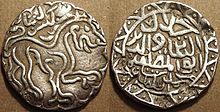
The taka was the currency of the Bengal Sultanate. Locations hosting a mint also served as provincial capitals, known as mint towns. The following includes a partial listing of mint towns in the Bengal Sultanate.[42]
- Lakhnauti
- Sonargaon
- Ghiaspur (Mymensingh)
- Satgaon
- Firuzabad (Pandua)
- Shahr-i-Naw (Pandua)
- Muzzamabad (Sonargaon)
- Jannatabad (Lakhnauti)
- Fathabad (Faridpur)
- Chatgaon (Chittagong)
- Rotaspur (Bihar)
- Mahmudabad (Jessore and Nadia)
- Barbakaabad (Dinajpur)
- Muzaffarabad (Pandua)
- Muahmmadabad
- Husaynabad (24 Parganas)
- Chandrabad (Murshidabad)
- Nusratabad (Bogra and Rangpur)
- Khalifatabad (Bagerhat)
- Badarpur (Bagerhat)
- Sharifabad (Birbhum)
- Tandah (Malda)
Foreign relations
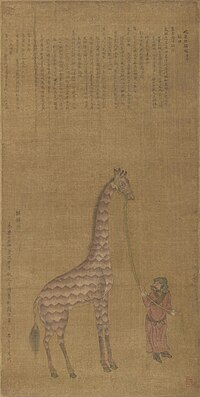


The Bengal Sultanate had robust foreign relations. Records show that the Bengal Sultanate exchanged embassies with states in China, Europe, Africa, Central Asia, South Asia and Southeast Asia. Diplomatic allies helped Bengal to fend off invasions from neighbouring kingdoms. For example, the Timurid ruler of Herat and the Ming emperor of China helped bring an end to the Bengal Sultanate-Jaunpur Sultanate War. Bengal was also active in regional diplomacy. For example, the ship of the Bengali embassy to China also transported the envoys of Brunei and Aceh (Sumatra) to China.[37] Bengal gave consent to envoys from Portuguese India for setting up Portuguese trading posts in coastal areas.[43] Other European visitors included Niccolo De Conti, Ludovico di Varthema and Caeser Fredrick from the Republic of Venice and Bologna.[44][45]
In the Islamic world, the sultanate pledged allegiance to the contemporary Abbasid Caliphate, which was at the time held by the Mamluk Sultan of Cairo. The Abbasid caliph was still considered to be the symbolic leader of Sunni Islam at the time, despite dwindling territory under direct caliphate rule. For the Bengali Sultans, relations with the caliphate provided legitimacy among the Muslim clergy. For example, the converted Sultan Jalaluddin Muhammad Shah received recognition from Al-Mu'tadid II, which strengthened Jalaluddin's legitimacy in the eyes of the clergy.[46] Many coins minted by the Bengal Sultanate bore the names of both the Bengali Sultans and the Abbasid Caliphs.[47]
Sultan Ghiyasuddin Azam Shah sponsored the construction of madrasas (Islamic theological schools) in the pilgrimage cities of Makkah and Madinah.[48] The schools became known as Ghiyasia Madrasas and Banjaliah (or Bengali) Madrasas. Taqi al-Din al-Fasi, a contemporary Arab scholar, was a teacher at the madrasa in Makkah. The madrasa in Madinah was built at a place called Husn al-Atiq near the Prophet's Mosque.[49] Several other Bengali Sultans also sponsored madrasas in the Hejaz.[46]
In Africa, Sultan Ashraf Barsbay of Egypt sent the Bengali Sultan a robe of honour and a letter of recognition.[50] There are also records of envoys from the East African city-state of Malindi being hosted in the Bengali court.[51] Animals constituted a significant part of tributes in medieval courts.[52] The East African envoys brought giraffes, which were also noticed by the Chinese envoys in Bengal.[51] In Central Asia, there are records of contacts between Sultan Jalaluddin Muhammad Shah and Sultan Shahrukh Mirza of the Timurid Empire. In Southeast Asia, European accounts refer to the presence of a large number of Bengali merchants in the Malacca Sultanate. The merchants were wealthy shipowners. It is yet to be ascertained whether these merchants had a significant role in the Sultan's court.[35] Ship-owning merchants were often royal envoys.[53] Contacts between Bengal and the Sultanates of Brunei and Aceh are recorded in Chinese accounts.[37]
Within the subcontinent, Bengal had both tense and peaceful relations with the Delhi Sultanate and the Jaunpur Sultanate. The Delhi Sultanate initially received tributes from the Bengal Sultanate between 1353 and 1359. Tributes stopped after a war and peace treaty in 1359. Sultan Ghiyasuddin Azam sent envoys to the neighboring Jaunpur Sultanate. He sent elephants as gifts to Sultan Malik Sarwar Khwajah-i-Jahan.[54] The two sultanates fought a war between 1415 and 1420. The end of the war brought a long period of peace between the neighbouring states. In 1494, the Jaunpuri Sultan Hussain Shah Sharqi was given refuge in Bengal after being defeated by the Lodi dynasty of Delhi.[55]
On the coastline of the Bay of Bengal, the Bengal Sultanate became influential in the control of Arakan. Min Saw Mon, a deposed Arakanese king, fled to Bengal after a Burmese invasion. With the support of Bengali forces led by a Pashtun general, he regained control of his country during the Reconquest of Arakan. The restored Arakanese realm became a vassal state of Bengal. A war with Arakan in 1459 led to the defeat of Bengali Sultan Rukunuddin Barbak Shah. The Arakanese developed an alliance with Portuguese Chittagong against Bengal. Despite achieving independence from the Sultans of Bengal, the Arakanese kings continued to fashion themselves after the Bengali Sultans by copying clothes, coins, titles and administrative techniques. Bengali Muslim influence on Arakan lasted for 350 years.[56] In the Indian Ocean, the Bengal Sultanate was involved in trading with the Maldives with Bengali rice exchanged for Maldivian shell currency.
Historians have focused on Bengal's relations with Ming China during the early 15th-century. For example, Trade and Diplomacy in India-China Relations: A Study of Bengal During the Fifteenth Century chronicles the relationship between the Bengal Sultanate and Ming China.[57] Scholars note that Sino-Indian relations during the 15th-century were mainly characterized by contacts between Bengal and China. This relationship was also noted by Indian independence leader Jawaharlal Nehru in the book The Discovery of India.[58] Political relations between China and the Indian subcontinent became nonexistent after the decline of Buddhism in India.[59] In the 15th-century, the Bengal Sultanate revived the subcontinent's relations with China through regular contacts. Sultan Ghiyasuddin Azam Shah began sending envoys to the Ming dynasty. He sent ambassadors in 1405, 1408 and 1409.[54] Emperor Yongle of China responded by sending ambassadors to Bengal between 1405 and 1433, including members of the Treasure voyages fleet led by Admiral Zheng He.[60] The exchange of embassies included the gift of an East African giraffe by Sultan Shihabuddin Bayazid Shah to the Chinese emperor in 1414.[52][61][60] China also mediated an end to the Bengal-Jaunpur War after a request from Sultan Jalaluddin Muhammad Shah.[46] Ming China considered Bengal to be "rich and civilized" and one of the strongest countries in the entire chain of contacts between China and Asian states during the 15th-century.[62] Fei Xin and Ma Huan were prominent travellers who wrote about their experiences in the Bengal Sultanate.
Culture and society


Bengali was the most spoken language while Persian was an administrative and commercial language. Men wore white shirts, cotton fabrics of various colors, turbans, sarongs, lungis, dhutis, leather shoes, and belts to wrap their robes on the waist. Women wore cotton saris. Upper-class women wore gold jewelry. There were various classes of artisans, as well as physicians and fortune tellers. There was a class of musicians who would gather by the houses of the rich during dawn and play music; and they would be rewarded with wine, food and money during breakfast hours. Some men would have performances with a chained tiger. The Hindu minority did not eat beef. The streets and markets included bathing areas, eating and drinking places, and dessert shops. Betel nut was offered to guests. The population included royalty, aristocrats, natives and foreigners. Many of the rich built ships and went abroad for trade. Many were agriculturalists. Punishments for breaking the law included expulsion from the kingdom, as well as bamboo flogging.[38]
Bengal received settlers from North India, the Middle East and Central Asia. They included Turks, Afghans, Persians and Arabs.[63] An important migrant community were Persians. Many Persians in Bengal were teachers, lawyers, scholars and clerics.[64] Mercenaries were widely imported for domestic, military and political service. One particular group of mercenaries were the Abyssinians.[30]
Arts
Literature
Muslim poets were writing in the Bengali language by the 15th century. By the turn of the 16th century, a vernacular literature based on concepts of Sufism and Islamic cosmology flourished in the region. Bengali Muslim mystic literature was one of the most original in Islamic India.[41]
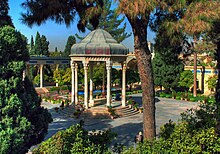

And with the three washers [cups of wine], this dispute is going on.
All the parrots [poets] of India have fallen into a sugar shattering situation (become excited)
That this Persian candy [ode], to Bangalah [Bengal] is going on.
-An excerpt of a poem jointly penned by Hafez and Sultan Ghiyasuddin Azam Shah in the 14th century.[65]
With Persian as an official language, Bengal witnessed an influx of Persian scholars, lawyers, teachers and clerics. It was the preferred language of the aristocracy and the Sufis. Thousands of Persian books and manuscripts were published in Bengal. The earliest Persian work compiled in Bengal was a translation of Amrtakunda from Sanskrit by Qadi Ruknu'd-Din Abu Hamid Muhammad bin Muhammad al-'Amidi of Samarqand, a famous Hanafi jurist and Sufi. During the reign of Ghiyasuddin Azam Shah, the city of Sonargaon became an important centre of Persian literature, with many publications of prose and poetry. The period is described as the "golden age of Persian literature in Bengal". Its stature is illustrated by the Sultan's own correspondence with the Persian poet Hafez. When the Sultan invited Hafez to complete an incomplete ghazal by the ruler, the renowned poet responded by acknowledging the grandeur of the king's court and the literary quality of Bengali-Persian poetry.[66]
In the 15th century, the Sufi poet Nur Qutb Alam pioneered Bengali Muslim poetry by establishing the Rikhta tradition, which saw poems written half in Persian and half in colloquial Bengali. The invocation tradition saw Islamic figures replacing the invocation of Hindu gods and goddesses in Bengali texts. The literary romantic tradition saw poems by Shah Muhammad Sagir on Yusuf and Zulaikha, as well as works of Bahram Khan and Sabirid Khan. The Dobhashi culture featured the use of Arabic and Persian words in Bengali texts to illustrate Muslim conquests. Epic poetry included Nabibangsha by Syed Sultan, Janganama by Abdul Hakim and Rasul Bijay by Shah Barid. Sufi literature flourished with a dominant theme of cosmology. Bengali Muslim writers produced translations of numerous Arabic and Persian works, including the Thousand and One Nights and the Shahnameh.[67][68]
Architecture
The large number of mosques built during the Bengal Sultanate indicates the rapidity with which the local population converted to Islam. The period between 1450 and 1550 was an intensive mosque building era. These mosques dotted the countryside, ranged from small to medium sizes and were used for daily devotion. Most mosques were either of rectangular or square shape. The rectangular building without an enclosed courtyard became a popular type for both large and medium-sized mosques. Bengali mosques would be covered several small domes. Other features of Bengali mosques would include corner towers, curved roofs, multiple mihrabs, pointed arches and in some cases, a dome in the shape of a hut's roof. Bengali mosques had a conspicuous absence of minarets. Ponds were often located beside a mosque. Arabic inscriptions in the mosques often include the name of the patron or builder. The most commonly cited verse from the Quran in inscriptions was Surah 72, Al-Jinn. A glimpse of houses in the Bengal Sultanate can be seen in the Iskandar Nama (Tale of Alexander) published by Sultan Nasiruddin Nasrat Shah.[69] Bengali sultanate-era mosques can be divided into two categories of multi-domed and single-domed mosques.
The buildings were made of brick. The brick mosque with terracotta decoration represented a grand structure in the Bengal Sultanate. They were often the gift of a wealthy patron and the fruit of extraordinary effort, which would not be found in every Muslim neighborhood.[69]
An exceptional building was the Adina Mosque, the imperial mosque of Bengal and the largest mosque ever built in the Indian subcontinent.[70] The monumental structure was designed in the hypostyle of early Islam with a plan similar to the Umayyad Mosque. The style is associated with the introduction of Islam in new areas.[69]
- Architecture of the Bengal Sultanate
-
Multiple mihrabs in Darasbari Mosque
-
Dakhil Doorway of Gauda
-
Interior dome of Bagha Mosque
-
Corner tower of Nine Dome Mosque
-
Multi-domed Pathrail Mosque
-
Single-domed Singair Mosque
-
Minaret of Sixty Dome Mosque
-
Corner tower with arabesque in Choto Sona Mosque
-
A do-chala dome with four circular domes
-
City wall of Gauda
-
Eklakhi Mausoleum, a royal tomb chamber
-
Gravestones resembling the Tomb of Cyrus
-
Terracotta arabesque
-
Royal gallery in Adina Mosque
-
Minbar in Qutb Shahi Mosque
List of rulers
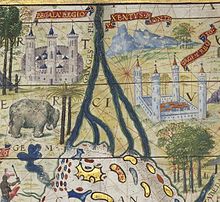
- Ilyas Shahi dynasty (1342-1414)
| Name | Reign | Notes |
|---|---|---|
| Shamsuddin Ilyas Shah | 1342–1358 | Became the first sole ruler of whole Bengal comprising Sonargaon, Satgaon and Lakhnauti. |
| Sikandar Shah | 1358–1390 | Assassinated by his son and successor, Ghiyasuddin Azam Shah |
| Ghiyasuddin Azam Shah | 1390–1411 | |
| Saifuddin Hamza Shah | 1411–1413 | |
| Muhammad Shah bin Hamza Shah | 1413 | Assassinated by his father's slave Shihabuddin Bayazid Shah on the orders of the landlord of Dinajpur, Raja Ganesha |
| Shihabuddin Bayazid Shah | 1413–1414 | |
| Alauddin Firuz Shah I | 1414 | Son of Shihabuddin Bayazid Shah. Assassinated by Raja Ganesha |
- House of Raja Ganesha (1414-1435)
| Name | Reign | Notes |
|---|---|---|
| Raja Ganesha | 1414–1415 | |
| Jalaluddin Muhammad Shah | 1415–1416 | Son of Raja Ganesha and converted into Islam |
| Raja Ganesha | 1416–1418 | Second Phase |
| Jalaluddin Muhammad Shah | 1418–1433 | Second Phase |
| Shamsuddin Ahmad Shah | 1433–1435 |
- Restored Ilyas Shahi dynasty (1435-1487)
| Name | Reign | Notes |
|---|---|---|
| Nasiruddin Mahmud Shah I | 1435–1459 | |
| Rukunuddin Barbak Shah | 1459–1474 | |
| Shamsuddin Yusuf Shah | 1474–1481 | |
| Sikandar Shah II | 1481 | |
| Jalaluddin Fateh Shah | 1481–1487 |
- Habshi rule (1487-1494)
| Name | Reign | Notes |
|---|---|---|
| Shahzada Barbak | 1487 | |
| Saifuddin Firuz Shah | 1487–1489 | |
| Mahmud Shah II | 1489–1490 | |
| Shamsuddin Muzaffar Shah | 1490–1494 |
- Hussain Shahi dynasty (1494-1538)
| Name | Reign | Notes |
|---|---|---|
| Alauddin Hussain Shah | 1494–1518 | |
| Nasiruddin Nasrat Shah | 1518–1533 | |
| Alauddin Firuz Shah II | 1533 | |
| Ghiyasuddin Mahmud Shah | 1533–1538 |
- Governors under Suri rule (1539-1554)
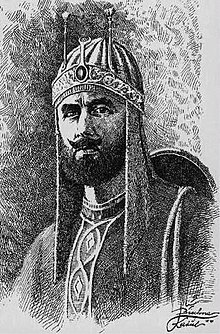
| Name | Reign | Notes |
|---|---|---|
| Khidr Khan | 1539–1541 | Declared independence in 1541 and was replaced |
| Qazi Fazilat | 1541–1545 | |
| Muhammad Khan Sur | 1545–1554 | Declared independence upon the death of Islam Shah Suri |
- Muhammad Shah dynasty (1554-1564)
| Name | Reign | Notes |
|---|---|---|
| Muhammad Khan Sur | 1554–1555 | Declared independence and styled himself as Shamsuddin Muhammad Shah |
| Ghiyasuddin Bahadur Shah I | 1555–1561 | |
| Ghiyasuddin Jalal Shah | 1561–1563 | |
| Ghiyasuddin Bahadur Shah II | 1563-1564 |
- Karrani dynasty (1564-1576)
| Name | Reign | Notes |
|---|---|---|
| Taj Khan Karrani | 1564–1566 | |
| Sulaiman Khan Karrani | 1566–1572 | |
| Bayazid Khan Karrani | 1572 | |
| Daud Khan Karrani | 1572–1576 |
See also
References
- ^ "Sonargaon - Banglapedia". en.banglapedia.org.
- ^ Snyder, Michael (9 May 2019). "In Bangladesh, Reimagining What a Mosque Might Be" – via NYTimes.com.
- ^ "History". Banglapedia. Archived from the original on 29 September 2017. Retrieved 23 September 2017.
Shah-i-Bangalah, Shah-i-Bangaliyan and Sultan-i-Bangalah
- ^ Wink, André (2003). Indo-Islamic society: 14th - 15th centuries. BRILL. ISBN 978-9004135611.
- ^ Uhlig, Siegbert (2003). Encyclopaedia Aethiopica. p. 151.
- ^ Embree, Ainslie (1988). Encyclopedia of Asian history. Asia Society. p. 149.
- ^ Keat Gin Ooi (2004). Southeast Asia: A Historical Encyclopedia, from Angkor Wat to East Timor. ABC-CLIO. p. 171. ISBN 978-1-57607-770-2.
- ^ a b Richard M. Eaton (31 July 1996). The Rise of Islam and the Bengal Frontier, 1204-1760. University of California Press. pp. 64–. ISBN 978-0-520-20507-9.
- ^ a b "Gaur and Pandua Architecture". Sahapedia.
- ^ Safvi, Rana (2 March 2019). "Once upon a fort: Gaur's Firoz Minar is still an imposing sight" – via www.thehindu.com.
- ^ Barbara Watson Andaya; Leonard Y. Andaya (19 February 2015). A History of Early Modern Southeast Asia, 1400-1830. Cambridge University Press. p. 114. ISBN 978-0-521-88992-6.
- ^ a b c Kunal Chakrabarti; Shubhra Chakrabarti (22 August 2013). Historical Dictionary of the Bengalis. Scarecrow Press. p. 12. ISBN 978-0-8108-8024-5.
- ^ http://en.banglapedia.org/index.php?title=Iliyas_Shah
- ^ Nitish K. Sengupta (2011). Land of Two Rivers: A History of Bengal from the Mahabharata to Mujib. Penguin Books India. p. 73. ISBN 978-0-14-341678-4.
- ^ a b c David Lewis (31 October 2011). Bangladesh: Politics, Economy and Civil Society. Cambridge University Press. pp. 44–45. ISBN 978-1-139-50257-3.
- ^ Richard M. Eaton (31 July 1996). The Rise of Islam and the Bengal Frontier, 1204-1760. University of California Press. ISBN 978-0-520-20507-9.
- ^ https://www.thedailystar.net/shout/cover-story/news/evolution-bangla-1705177
- ^ http://en.banglapedia.org/index.php?title=Ghiyasuddin_Azam_Shah
- ^ http://en.banglapedia.org/index.php?title=Coins
- ^ http://en.banglapedia.org/index.php?title=Jalaluddin_Muhammad_Shah
- ^ Eaton, Richard M. (31 July 1996). The Rise of Islam and the Bengal Frontier, 1204-1760. ISBN 9780520205079.
- ^ https://www.livehistoryindia.com/cover-story/2018/06/25/pandua-the-lost-capital-of-the-sultanate-of-bengal
- ^ María Dolores Elizalde; Wang Jianlang (6 November 2017). China's Development from a Global Perspective. Cambridge Scholars Publishing. pp. 57–70. ISBN 978-1-5275-0417-2.
- ^ Aniruddha Ray (13 September 2016). Towns and Cities of Medieval India: A Brief Survey. Taylor & Francis. p. 165. ISBN 978-1-351-99731-7.
- ^ http://en.banglapedia.org/index.php?title=Sonargaon
- ^ http://whc.unesco.org/en/list/321
- ^ a b http://en.banglapedia.org/index.php?title=Portuguese,_The
- ^ Vadime Elisseeff (1998). The Silk Roads: Highways of Culture and Commerce. Berghahn Books. p. 161. ISBN 978-1-57181-221-6. Archived from the original on 15 May 2018.
- ^ Eaton, Richard M. (1993). The Rise of Islam and the Bengal Frontier, 1204-1760. Berkeley: University of California Press. pp. 140–2. ISBN 0-520-20507-3.
- ^ a b electricpulp.com. "BENGAL – Encyclopaedia Iranica". www.iranicaonline.org. Archived from the original on 30 September 2017.
- ^ "He founded the Bengali Husayn Shahi dynasty, which ruled from 1493 to 1538, and was known to be tolerant to Hindus, employing many on them in his service and promoting a form of religious pluralism" David Lewis (31 October 2011). Bangladesh: Politics, Economy and Civil Society. Cambridge University Press. pp. 44–45. ISBN 978-1-139-50257-3.
- ^ a b c "Military - Banglapedia". En.banglapedia.org. Archived from the original on 23 September 2017. Retrieved 22 September 2017.
- ^ "BENGAL". Encyclopedia Iranica. Archived from the original on 3 January 2018.
- ^ John H Munro (6 October 2015). Money in the Pre-Industrial World: Bullion, Debasements and Coin Substitutes. Routledge. p. 176. ISBN 978-1-317-32191-0.
- ^ a b Irfan Habib (2011). Economic History of Medieval India, 1200-1500. Pearson Education India. p. 185. ISBN 978-81-317-2791-1.
- ^ a b Rila Mukherjee (2011). Pelagic Passageways: The Northern Bay of Bengal Before Colonialism. Primus Books. p. 30. ISBN 978-93-80607-20-7.
- ^ a b c Tapan Raychaudhuri Irfan Habib Dharma Kumar Meghnad Desai (1982). The Cambridge Economic History of India: Volume 1, C.1200-c.1750. CUP Archive. p. 130. ISBN 978-0-521-22692-9.
- ^ a b María Dolores Elizalde; Wang Jianlang (6 November 2017). China's Development from a Global Perspective. Cambridge Scholars Publishing. pp. 57–70. ISBN 978-1-5275-0417-2.
- ^ Nanda, J. N (2005). Bengal: the unique state. Concept Publishing Company. p. 10. 2005. ISBN 978-81-8069-149-2. Bengal [...] was rich in the production and export of grain, salt, fruit, liquors and wines, precious metals and ornaments besides the output of its handlooms in silk and cotton. Europe referred to Bengal as the richest country to trade with.
- ^ a b Sushil Chaudhury (2012). "Trade and Commerce". In Sirajul Islam and Ahmed A. Jamal (ed.). Banglapedia: National Encyclopedia of Bangladesh (Second ed.). Asiatic Society of Bangladesh.
- ^ a b Claude Markovits (1 February 2004). A History of Modern India, 1480-1950. Anthem Press. p. 37. ISBN 978-1-84331-004-4. Archived from the original on 15 May 2018.
- ^ "Mint Towns - Banglapedia". En.banglapedia.org. 5 April 2014. Archived from the original on 1 July 2017. Retrieved 22 September 2017.
- ^ "Portuguese, The - Banglapedia". en.banglapedia.org. Archived from the original on 1 April 2017.
- ^ "Conti, Nicolo de - Banglapedia". en.banglapedia.org. Archived from the original on 4 March 2016.
- ^ "Frederick, Caeser - Banglapedia". en.banglapedia.org. Archived from the original on 6 April 2018.
- ^ a b c "Jalaluddin Muhammad Shah - Banglapedia". en.banglapedia.org. Archived from the original on 7 July 2015.
- ^ Muhammad Rezaul Karim. "Coins". Banglapedia: National Encyclopedia of Bangladesh. Asiatic Society of Bangladesh.
- ^ Richard M. Eaton (31 July 1996). The Rise of Islam and the Bengal Frontier, 1204-1760. University of California Press. p. 47. ISBN 978-0-520-20507-9. Archived from the original on 6 January 2017.
- ^ Abdul Karim. "Ghiyasia Madrasa". Banglapedia: National Encyclopedia of Bangladesh. Asiatic Society of Bangladesh.
- ^ Richard Maxwell Eaton (1993). The Rise of Islam and the Bengal Frontier, 1204-1760. University of California Press. p. 57. ISBN 978-0-520-08077-5.
- ^ a b N. W. Sobania (2003). Culture and Customs of Kenya. Greenwood Publishing Group. p. 14. ISBN 978-0-313-31486-5.
- ^ a b Lin Ma; Jaap van Brakel (25 March 2016). Fundamentals of Comparative and Intercultural Philosophy. SUNY Press. p. 135. ISBN 978-1-4384-6017-8.
- ^ María Dolores Elizalde; Wang Jianlang (6 November 2017). China's Development from a Global Perspective. Cambridge Scholars Publishing. p. 68. ISBN 978-1-5275-0417-2.
- ^ a b "Ghiyasuddin Azam Shah - Banglapedia". en.banglapedia.org. Archived from the original on 3 July 2015.
- ^ Perween Hasan (15 August 2007). Sultans and Mosques: The Early Muslim Architecture of Bangladesh. I.B.Tauris. p. 16. ISBN 978-1-84511-381-0.
- ^ William J. Topich; Keith A. Leitich (9 January 2013). The History of Myanmar. ABC-CLIO. p. 20. ISBN 978-0-313-35725-1.
- ^ Ptak, Roderich (2 July 1995). "Trade and Diplomacy in India-China Relations: A Study of Bengal During the Fifteenth Century. By Haraprasad Ray. pp. ix, 221, 3 maps. New Delhi, Radiant Publishers; London, Sangam Books, 1993. Rs 200". Journal of the Royal Asiatic Society. 5 (2): 300–303. doi:10.1017/S1356186300015637 – via Cambridge Core.
- ^ Jawaharlal Nehru (1985). The discovery of India. Oxford University Press. p. 198. ISBN 978-0-19-562359-8.
- ^ India and China: Interactions through Buddhism and Diplomacy: A Collection of Essays by Professor Prabodh Chandra Bagchi. Anthem Press. 1 October 2011. p. 109. ISBN 978-0-85728-821-9. Archived from the original on 15 May 2018.
- ^ a b Church, Sally K. (2016). "The Giraffe of Bengal: A Medieval Encounter in Ming China". The Medieval History Journal. 7: 1–37. doi:10.1177/097194580400700101.
- ^ Giorgio Riello; Zoltán Biedermann; Anne Gerritsen (28 December 2017). Global Gifts: The Material Culture of Diplomacy in Early Modern Eurasia. Cambridge University Press. p. 18. ISBN 978-1-108-41550-7. Archived from the original on 15 May 2018.
- ^ María Dolores Elizalde; Wang Jianlang (6 November 2017). China's Development from a Global Perspective. Cambridge Scholars Publishing. p. 70. ISBN 978-1-5275-0417-2.
- ^ Muhammad Mojlum Khan (21 October 2013). The Muslim Heritage of Bengal: The Lives, Thoughts and Achievements of Great Muslim Scholars, Writers and Reformers of Bangladesh and West Bengal. Kube Publishing Limited. pp. 5–. ISBN 978-1-84774-062-5. Archived from the original on 15 May 2018.
- ^ "Iranians, The - Banglapedia". Archived from the original on 17 November 2015.
- ^ "Persian - Banglapedia". En.banglapedia.org. 15 February 2015. Archived from the original on 11 September 2017. Retrieved 22 September 2017.
- ^ "Persian – Banglapedia". Archived from the original on 2 January 2017.
- ^ "The development of Bengali literature during Muslim rule" (PDF). Archived (PDF) from the original on 9 August 2017. Retrieved 22 September 2017.
- ^ "Sufi Literature – Banglapedia". Archived from the original on 11 September 2016.
- ^ a b c Oleg Grabar (1989). Muqarnas: An Annual on Islamic Art and Architecture. Brill Archive. pp. 58–72. ISBN 978-90-04-09050-7.
- ^ Richard M. Eaton (31 July 1996). The Rise of Islam and the Bengal Frontier, 1204-1760. University of California Press. pp. 40–50. ISBN 978-0-520-20507-9. Archived from the original on 6 January 2017.
Notes
- ^ Sultan Ghiyasuddin Azam Shah held his court in Sonargaon.
Further reading
- Yegar, Moshe (2002). Between Integration and Secession: The Muslim Communities of the Southern Philippines, Southern Thailand, and Western Burma/Myanmar. Lanham, MD: Lexington Books. pp. 23–24. ISBN 978-0-7391-0356-2.
- Hussain, Syed Ejaz (2003). The Bengal Sultanate: Politics, Economy and Coins, A.D. 1205–1576. Manohar. ISBN 978-81-7304-482-3.
- The Grammar of Sultanate Mosque in Bengal Architecture, Nujaba Binte Kabir (2012)














